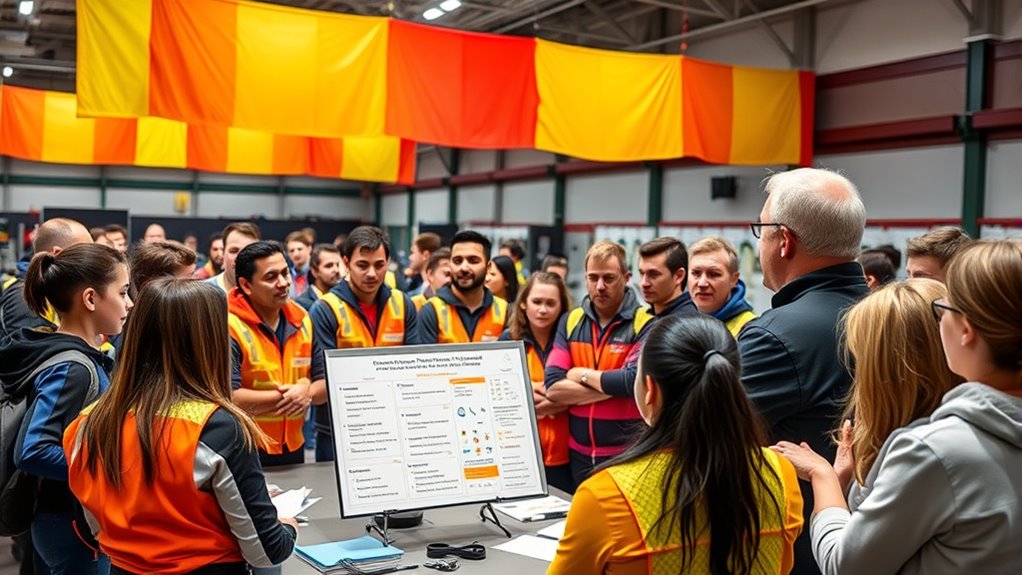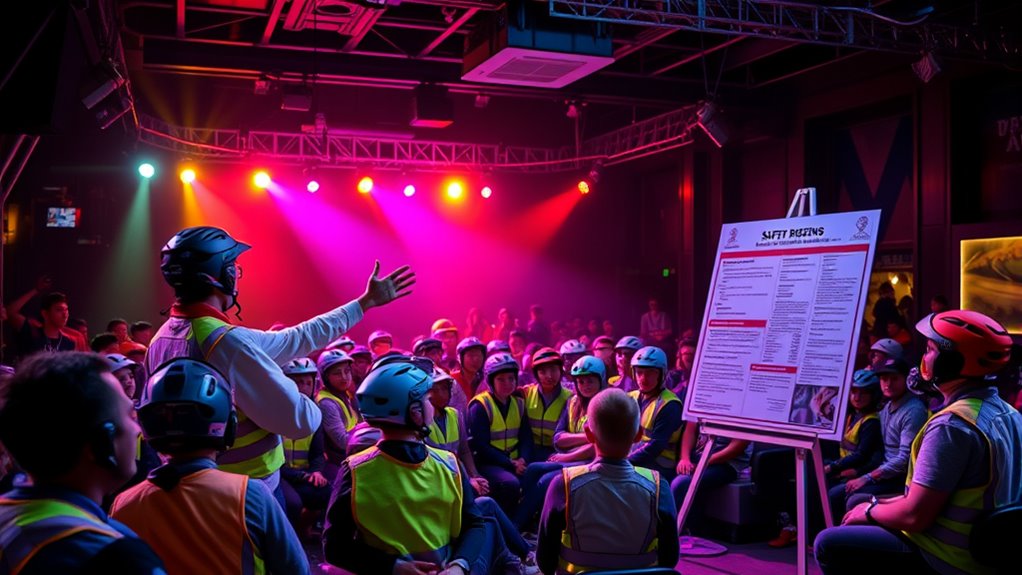Safety briefings at clubs and competitions play a vital role in ensuring you understand safety rules, hazard identification, and emergency procedures. They help you communicate effectively with your team, prevent accidents caused by faulty equipment, and foster a safety-first mindset. By actively engaging in these briefings, you contribute to a secure environment for everyone to enjoy. Keep exploring to discover how tailored protocols can boost your safety awareness and response skills even further.
Key Takeaways
- Safety briefings establish clear rules and procedures, minimizing risks during club activities and competitions.
- They inform participants of emergency exits, response steps, and safety protocols to ensure quick action during incidents.
- Briefings verify equipment safety and proper use, preventing accidents caused by faulty or misused gear.
- They promote hazard awareness and effective communication, enabling team members to respond appropriately to emergencies.
- Safety briefings foster a safety-first culture, encouraging active participation and collective responsibility for a secure environment.

Safety briefings at clubs and competitions are essential for ensuring everyone understands the rules and procedures to stay safe. When you participate in any organized activity, especially those involving physical risks or specialized equipment, it’s imperative to be aware of the safety measures in place. During these briefings, you’ll learn about emergency protocols, which outline the steps to take if something goes wrong. Knowing these protocols helps you respond quickly and effectively, minimizing injury or damage. For example, you’ll be informed about the location of emergency exits, the procedures for reporting accidents, and the roles of safety personnel. Having a clear understanding of emergency protocols ensures that everyone on-site can act confidently and cohesively in critical moments. Additionally, reviewing safety guidelines ensures that participants are aware of the specific precautions necessary for different types of activities. Equipment checks form an indispensable part of the safety briefing. Before you start any activity, you’ll be instructed to inspect your gear thoroughly. This process involves verifying that all equipment is in good condition, correctly fitted, and functioning properly. Equipment checks help prevent accidents caused by faulty or improperly used gear. For instance, if you’re involved in a sport like rock climbing or shooting, ensuring your harness, helmet, or firearm is secure and operational can make the difference between a safe experience and an incident. Safety briefings emphasize the importance of ongoing equipment checks, not just before the activity begins, but periodically throughout. This ongoing vigilance helps catch potential issues early, reducing the risk of equipment failure during use. The safety briefing also covers specific procedures for different scenarios. You’ll learn how to identify hazards, communicate effectively with team members, and follow established protocols during emergencies. These procedures are designed to create a safe environment and protect everyone involved. By actively listening and engaging during the briefing, you’re better prepared to follow the rules and respond appropriately if a situation arises. The goal is to foster a safety-first mindset, where you feel confident in your knowledge of emergency protocols and equipment safety. Ultimately, safety briefings serve as a foundation for a secure experience. They’re not just a formality but a critical step to prevent accidents and ensure everyone’s well-being. Taking these briefings seriously means you’re committed to your safety and that of others. By understanding emergency protocols and conducting thorough equipment checks, you help create a safer environment where fun and competition can thrive without unnecessary risks.
Frequently Asked Questions
How Often Should Safety Briefings Be Conducted?
You should conduct safety briefings regularly, ideally before each event or session, to guarantee everyone stays informed. Frequency planning depends on the activity’s complexity and participants’ experience, so consider daily or weekly briefings for ongoing activities. Use varied briefing formats like face-to-face, written, or digital to keep engagement high. Consistent, well-structured briefings help prevent accidents and promote a safety-first environment.
Who Is Responsible for Delivering Safety Briefings?
You are responsible for delivering safety briefings, ensuring they include pre-brief responsibilities and relevant safety briefing training. You should be well-trained and familiar with safety protocols to communicate effectively. Your role involves clearly explaining safety procedures, addressing questions, and emphasizing the importance of following guidelines. By actively engaging participants, you help create a safe environment where everyone understands their responsibilities, reducing risks during club activities and competitions.
Are Safety Briefings Mandatory for All Participants?
Think of safety briefings as your map through a busy maze—they’re usually mandatory for all participants. You need hazard communication and emergency procedures to stay safe and navigate surprises confidently. Skipping them is like ignoring warning signs on a stormy sea; it puts you at risk. So, yes, attending safety briefings guarantees you’re prepared, aware of hazards, and know what to do in an emergency, keeping everyone safer.
What Topics Are Typically Covered in Safety Briefings?
In club safety briefings, you typically cover essential topics like emergency procedures, equipment handling, and safety protocols. The briefing content often includes club safety rules, communication methods, and specific hazards related to the activity. You’re informed about safe practices, the location of safety gear, and how to respond during incidents. This guarantees everyone understands their roles, promotes safety awareness, and helps prevent accidents during club activities and competitions.
How Is Compliance With Safety Instructions Monitored?
While safety culture emphasizes individual responsibility, compliance with safety instructions is actively monitored through staff oversight and peer accountability. You’re expected to follow procedures consistently, supported by risk assessments that identify potential hazards. Supervisors observe adherence, and any deviations prompt immediate correction. This dual approach guarantees safety remains a priority, fostering a culture where everyone recognizes their role in maintaining a safe environment and understands that safety isn’t optional but essential.
Conclusion
Remember, safety briefings aren’t just formalities—they’re your best defense. Some say they’re just a box to check, but in reality, they can prevent accidents and save lives. Imagine if everyone ignored them; chaos could quickly follow. So, take briefings seriously, stay alert, and communicate openly. When you do, you create a safer environment for everyone, proving that a quick chat can be the difference between fun and tragedy.
With a heart that soars as high as the skies, Aria, affectionately known as “Skylark,” is the driving force behind Soaring Skyways. Her journey into the gliding world began as a young dreamer gazing up at the soaring birds, yearning to experience the weightlessness and freedom they embodied. With years of experience both in the cockpit and behind the scenes, Aria’s commitment to the gliding community is unwavering.









